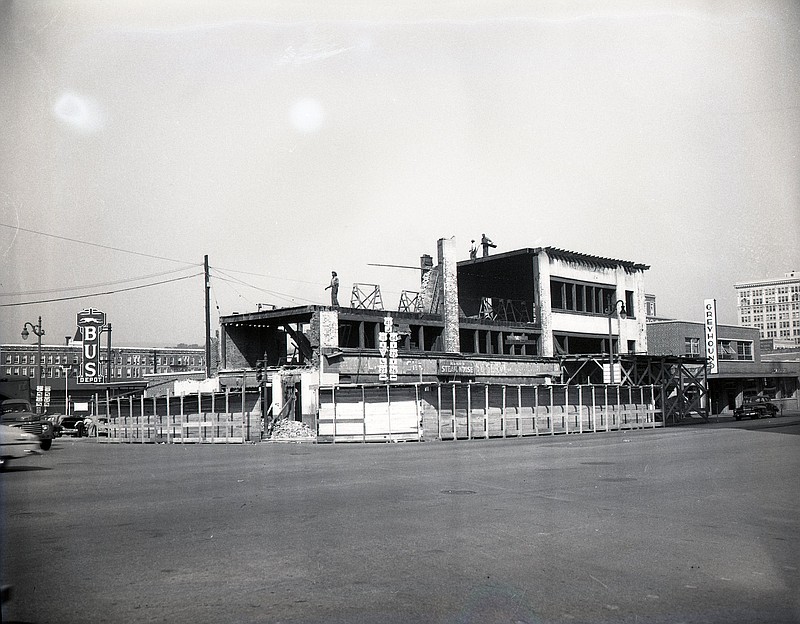For a span of years before and after World War II, Greek immigrant Harry Koskos was one of Chattanooga's best-known restaurateurs. He had come to the United States penniless at age 14 and worked his way to prominence, according to newspaper reports.
The accompanying photo shows the former Harry's Steak House at 11th and Market streets being torn down in 1951 to clear space for a parking lot. Koskos, the owner, had died two years earlier, in 1949.
Before it was a steak house, the restaurant was called Harry's Place. It was operated by Koskos and his wife, Sophia, who was also a naturalized American citizen born in Greece.
In the 1930s, Harry's Place was open 24 hours a day, seven days a week and was said to be the first restaurant in Chattanooga to offer curb service.
For much of the second half of the 20th century, the block pictured here was occupied by the Civic Forum, which was home to the Chattanooga Chamber of Commerce, among other agencies.
The Civic Forum building was torn down in the early 2000s, and the block remains a parking lot.
The land was once considered a possible site for a new Chattanooga federal courts building, but it was ultimately deemed too small. The search for a suitable spot for a new federal building continues.
When this photo was made, the block was owned by the state of Georgia and leased to the Nashville, Chattanooga & St. Louis Railway. Interestingly, for many years, Georgia owned a stretch of land in downtown Chattanooga. The arrangement dated back to the early 19th century when Tennessee lawmakers allowed the neighboring state to acquire the right of way for an Atlanta-to-Chattanooga railroad and its terminal station.
At points, the city of Chattanooga tried to get the land back for street construction. According to an article at the website ChattanoogaHistory.com: "Legal battles with the state of Georgia continued (through much of the 20th century) – eventually escalating to the U.S. Supreme Court, where it was ruled the city had the right to use eminent domain to acquire the Georgia-owned property. One-by-one, Georgia's larger parcels of land were sold, most in the 1970s."
Meanwhile, Harry's Steak House was in and out of the news through the 1930s and 1940s. In 1937, it was reported that Harry's was one of only a handful of Chattanooga restaurants that resisted hiring union workers.
In July 1948, burglars climbed through the ductwork at Harry's and stole $60o in cash from the restaurant's safe, according to police reports.
A more dangerous incident happened in September 1945, when a man was accused of shooting at his wife inside the restaurant. Ultimately, a city judge released the man after his wife explained the situation.
"His pretty wife, 18, told the court that her husband didn't shoot to kill her during the argument," the Chattanooga News-Free Press reported. Rather, the young woman said, "He put one arm around me and shot in the other direction."
At the time this photograph was made, the Greyhound Bus Depot near Harry's was a busy place. Just a year earlier, the new bus terminal had been built virtually surrounding the steak house property. The T-shaped Greyhound building had entrances on 10th, 11th and Market streets.
Newspaper ads of the day were headlined, "There's something about Greyhound that makes it a friendly way to travel."
It was also an economical way to travel. In 1951, a one-way bus ticket from Chattanooga to Atlanta was $3, and a traveler could ride a bus all the way from Chattanooga to Dallas one way for $14.45.
See other photos in this series at ChattanoogaHistory.com, and follow the "Remember When, Chattanooga?" public group on Facebook.
"Remember When, Chattanooga?" is published on Saturdays. Contact Mark Kennedy at mkennedy@timesfreepress.com or 423-757-6645. Follow him on Twitter @TFPcolumnist.
